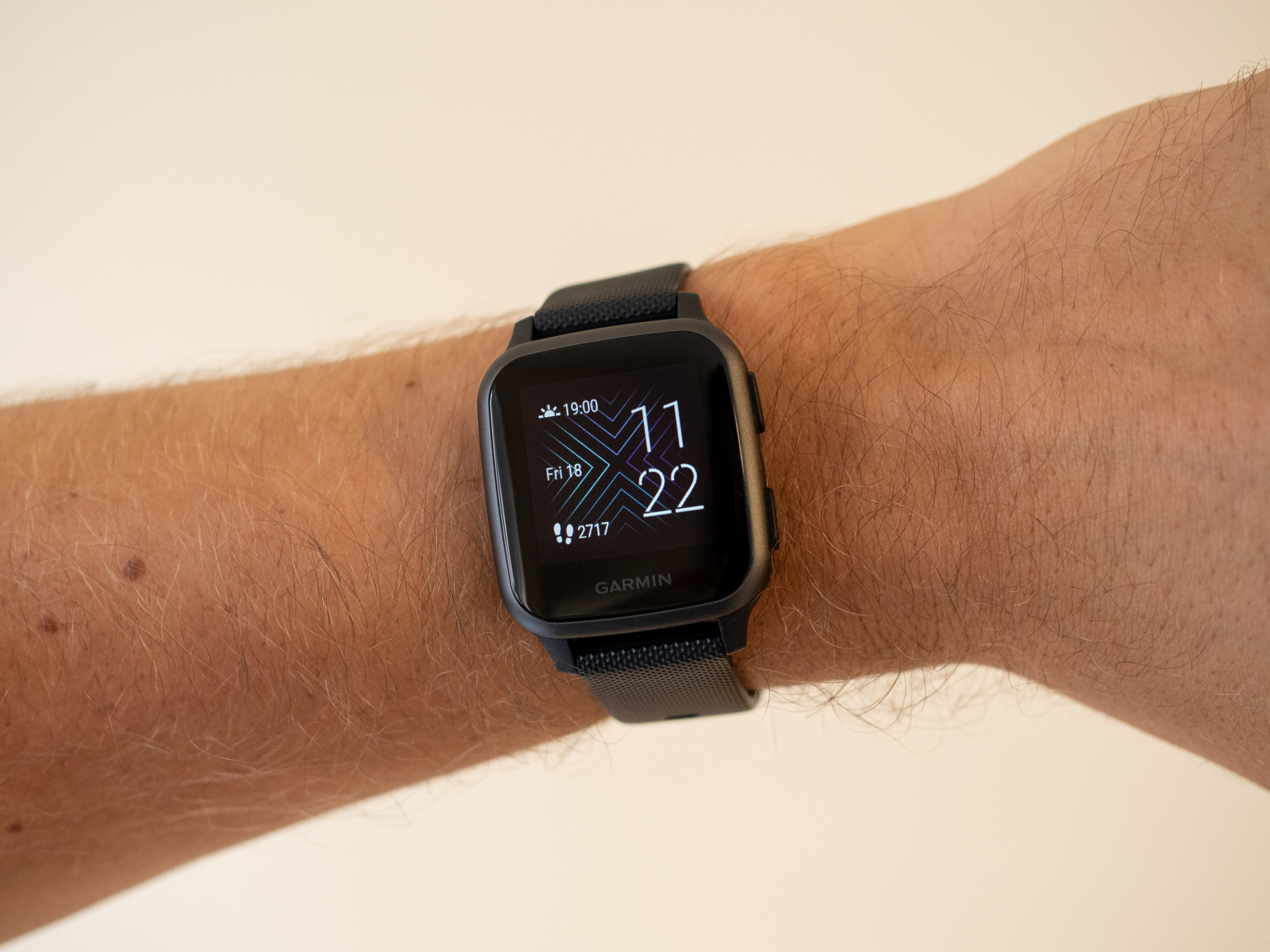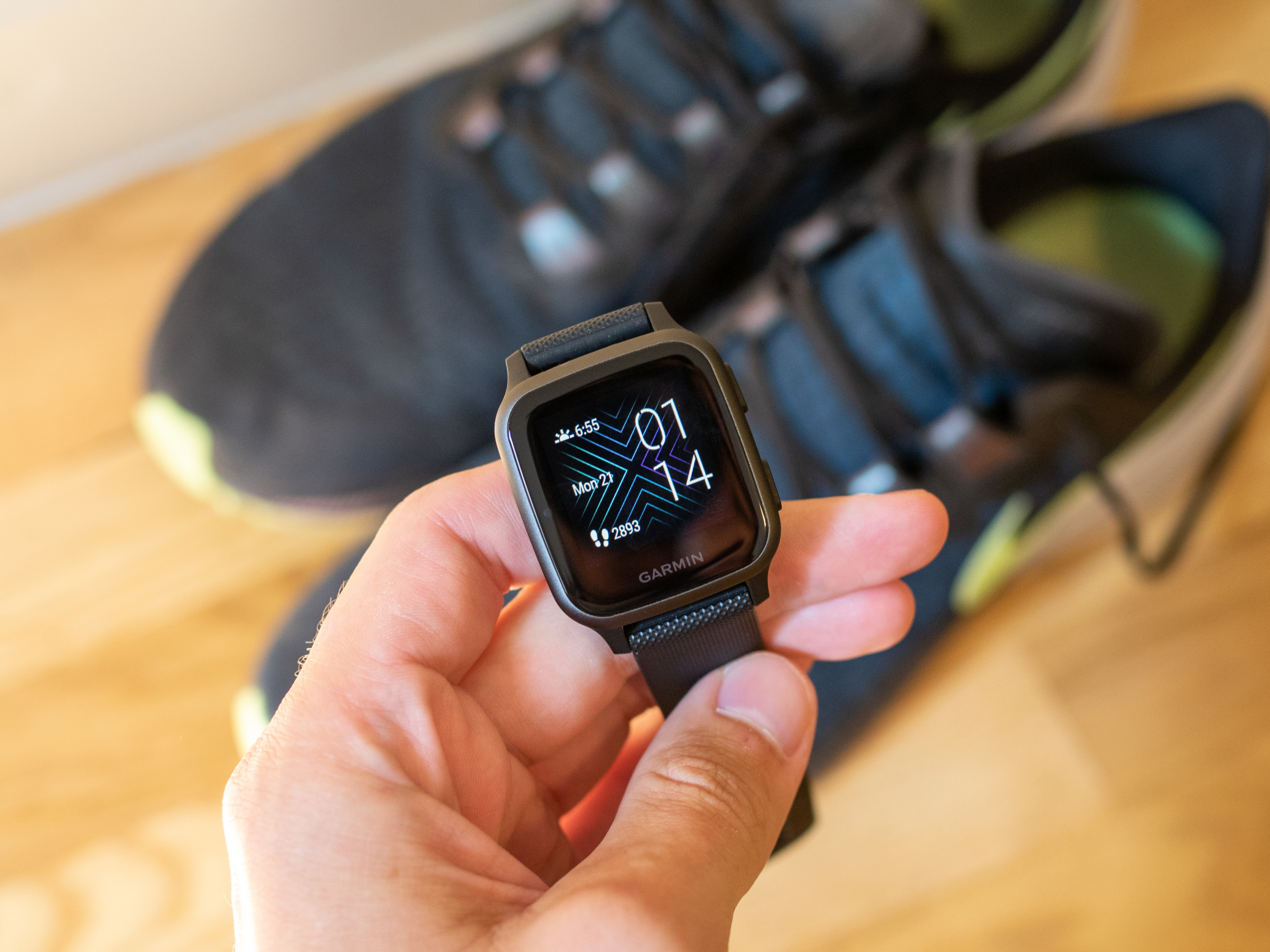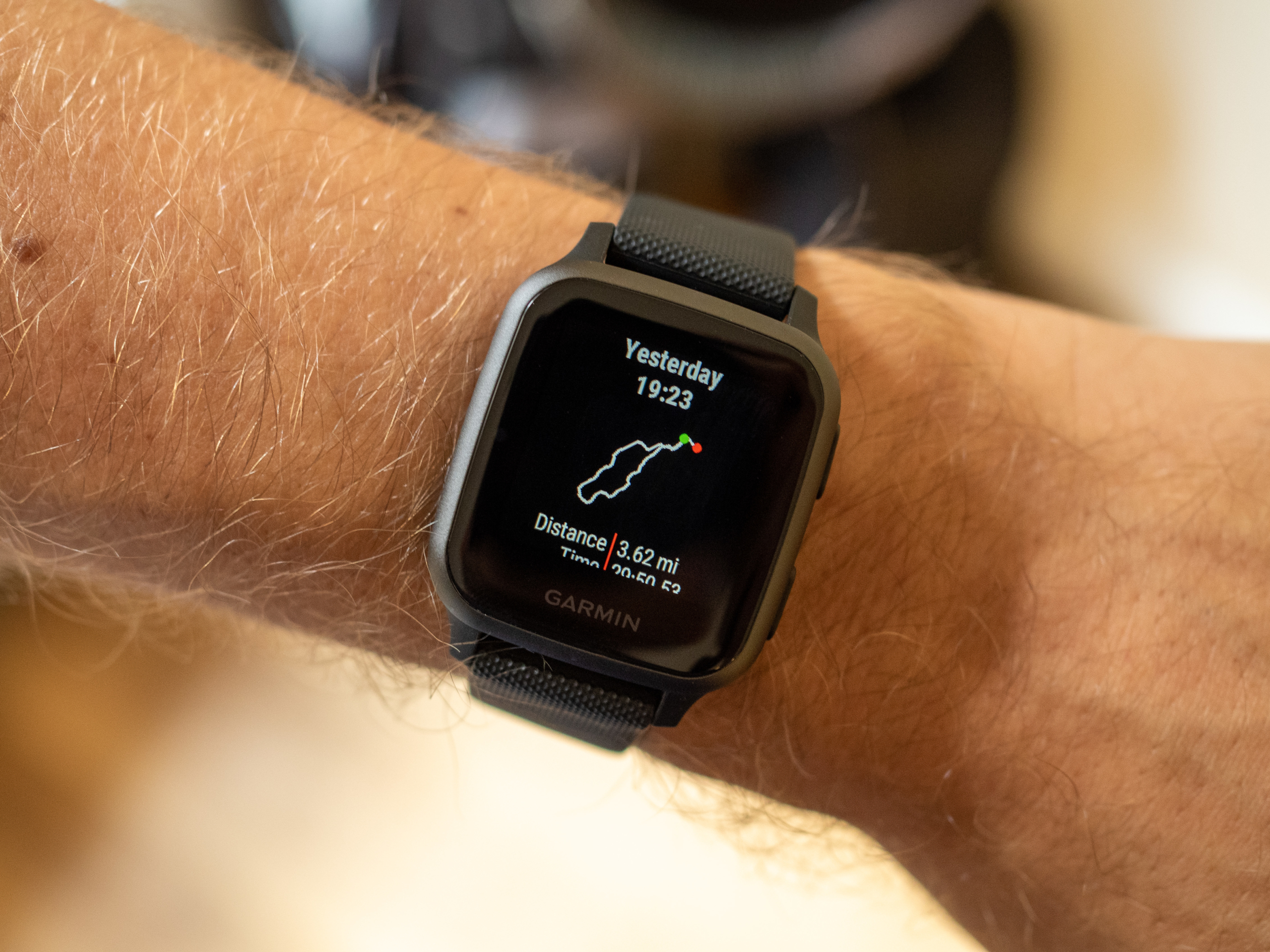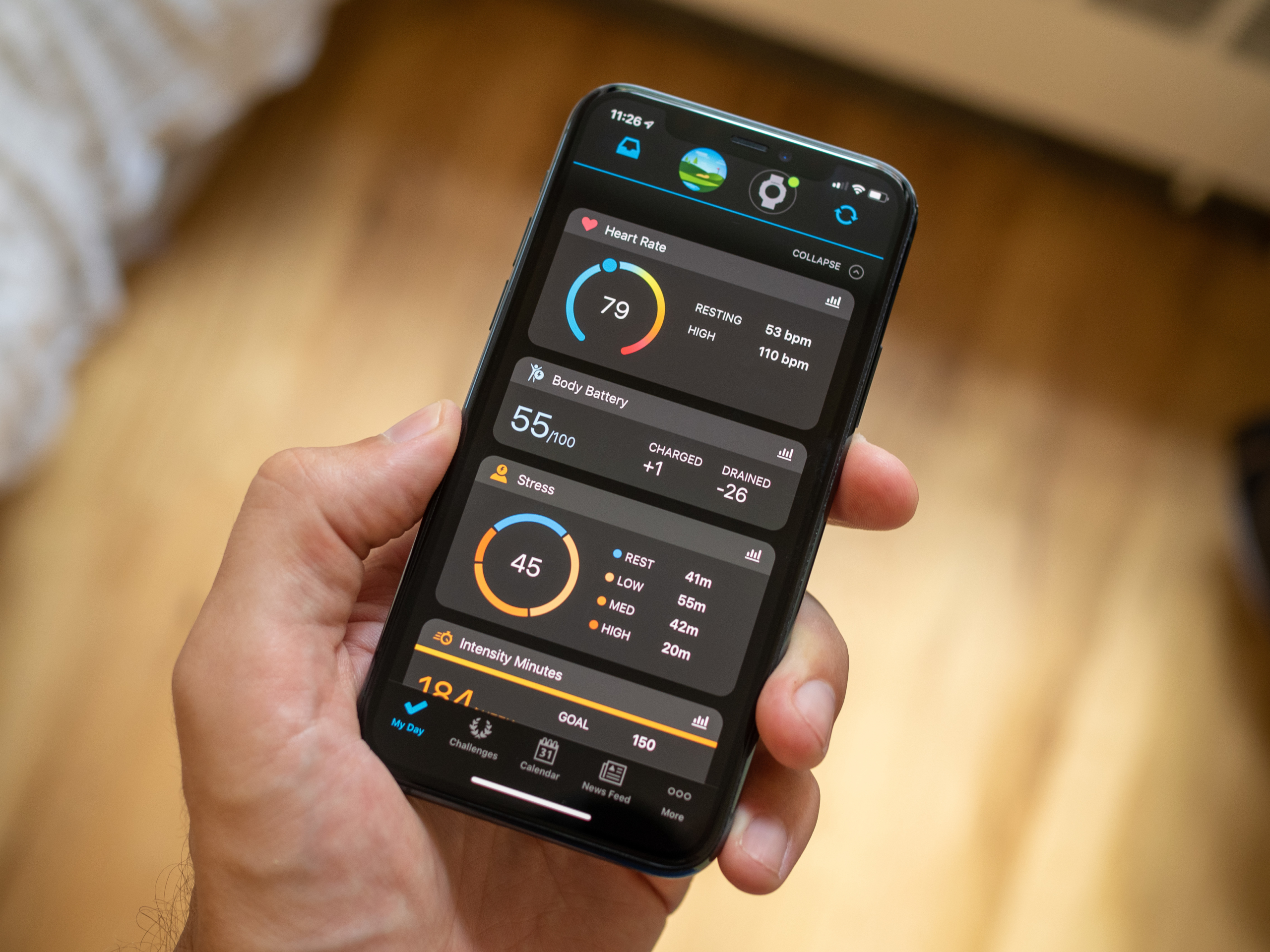- Reliable and accurate activity tracking
- In-depth data collection and analysis
- Simple and lightweight design
- Support for dozens of workout types
- Nearly week-long battery life
- $50 up-sell for music functionality
- Touchscreen can be finicky during workouts
- Limited "smart" features and notifications
You’d be hard-pressed to find someone who doesn’t know Garmin, and more often than not, they’ll know the company’s extensive line of fitness-focused smartwatches. It has a well-deserved reputation for making the highest-end and most-accurate watches for runners, bikers, triathletes, and every other possible outdoor sport.
But Garmin doesn’t just want to play in the “pro” space. There’s reason to believe the Garmin name can translate into sales on the affordable end of the scale, competing with entry-level smartwatches and high-end fitness bands. This is where the Garmin Venu Sq comes in.
Hardware and features
You can’t see it any other way. The Venu Sq looks like an Apple Watch. I know, there are only so many ways to make a rounded-rectangle smartwatch, but it’s hard to miss. Just a couple days after getting the Venu Sq, I was at soccer practice, and a teammate asked how I liked my Apple Watch.

The plastic body is effective, albeit light and cheap-feeling (remember, it’s only $200). The brushed aluminum piece surrounding the curved-glass display covering is a nice bit of contrast, though, and it’s neither thick nor bulbous around the back where the sensor array is.

The display is just 1.3 inches diagonal, with a 240 x 240 resolution, but it definitely gets the job done. It has ambient brightness adjustment, and was easily viewable in sunlight, while also getting plenty dim at night. There’s a large bezel around the screen, which doesn’t look great, but honestly doesn’t have an impact on how well you can use the watch considering how simple the software is.
This is a fitness-first smartwatch, not a general “little phone on your wrist” device, so its smart functionality is basic. You can customize watch faces with some basic designs and data layouts, but it’s not nearly as extensive as Apple’s. Notifications come to your wrist, and you can act on them if you’re paired to an Android phone, but otherwise you can’t do much outside of health and fitness. No messaging, apps, or advanced features here. And the vibration motor is very loud.

Even with a color touchscreen, the Venu Sq still has superb battery life by general smartwatch standards. Even with a constant Bluetooth connection bringing in notifications from my phone, overnight sleep tracking, and 4-5 hours of GPS workout tracking, I was easily getting 5 days of battery life. This is without the “always on” display, which would surely cut a couple days off of that, but I found having a long delay on the display timeout to be a fine middle-ground.
Health, activity, and workout tracking
For a $200 fitness watch, the Venu Sq delivers where it matters. Sensors and tracking capabilities. You’re getting the same core tracking and analytics as a $600 Garmin Fenix 6, running into the same great Garmin Connect app on your phone. Constant, accurate heart rate monitoring is here, plus the usual step count and active minutes reading. Garmin’s reputation for having accurate GPS tracking for running and biking also held true in my testing, perfectly following my activities.

Garmin uses the idea of a “Body Battery” to measure your overall physical condition, which can be fun to track from day to day. But you also get a physical stress reading, calories burned, sleep analysis, training load analysis, and workout suggestions — again, all identical to much more expensive Garmin watches.
Every popular activity has a pre-made mode you can jump to and start tracking with in a couple of taps, from running and biking to stand-up paddle board, cross-country skiing, rowing, track, yoga, elliptical, golf, and more. The list is long.
The Venu Sq also offers SpO2 (aka Pulse Ox) tracking, like many of its other watches, which is something you otherwise only get on the latest Apple Watch Series 6. You shouldn’t put a ton of weight into an SpO2 reading from a consumer smartwatch, but if it’s something you’re focused on as part of your overall health picture, it’s here.

The one thing you’re missing out on is a barometer, so you can’t get any sort of elevation-related tracking. No daily stair climb tracking, and more importantly, any elevation information for hikes or running/biking on trails. This isn’t so important for most people, but anyone who takes their running or biking seriously will really miss getting precise elevation data and elevation-adjusted pace analysis.
While the touchscreen is nice for everyday use and navigation, it isn’t the best interface for dealing with the watch during a workout. Touchscreens work poorly with sweaty fingers and get accidentally triggered by sleeves and rain. After accidentally ending a run once, I turned on the screen lock, which unfortunately also disables the side buttons — an annoying trade-off, but an overall improvement. It may seem gaudy to have a watch with 5 physical buttons, like Garmin’s other models, but it really is the way to interface with a watch while working out or wearing gloves.
Like most of its watches, Garmin has an up-sell charge to add music functionality to the Venu Sq. You pay an extra $50 for local storage on the watch that can sync music to Spotify, Amazon Music or Deezer, and play back to your headphones directly. This isn’t a big deal for me while running or biking, since it doesn’t support YouTube Music (c’mon!) and I’ll always have my phone on me, but I know many people want to go phone-free and still have their Spotify playlists. With general-purpose smartwatches having music functionality built-in across the board, a 25% price premium to get it on the Venu Sq is rough.
Our take
The Venu Sq is well positioned as a full step up from basic fitness bands, like the Fitbit Inspire 3, with a watch-style shape and large screen, but without the big price increase of moving to a full-featured smartwatch from Apple or a high-end fitness watch from Polar or Garmin itself.
You get accurate activity, health, and workout tracking, backed up by the aggregation and analysis of Garmin’s smartphone app that gives you all of the same features you’d expect from a much more expensive watch. Yet it doesn’t look like a hardcore fitness watch, which is likely a bonus for people looking to spend just $200 on this sort of wearable.
There are clear shortcomings here if you take your fitness very seriously and need more precise tracking, more sensors, or hardware buttons. But again, remember the price. The Venu Sq is a great aspirational fitness-focused smartwatch that splits the difference between casual and pro users, while also looking more like a general-purpose smartwatch.
Is there a better alternative?
Garmin’s biggest competitor is undoubtedly the Apple Watch Series 3, which is relatively old but still fully supported and sold brand new by Apple for $199. The Watch Series 3 is clearly not as capable for tracking workouts and providing granular fitness data, but if you have an iPhone it will offer a more holistic lifestyle smartwatch experience with better apps, notifications, and interface. And the draw of services like Apple Fitness+ can’t be understated.
If you want to focus specifically on tracking your runs, bike rides, and serious workouts, a more dedicated fitness smartwatch like the Garmin Forerunner 245 will make more sense. It’s more expensive, at $275, but it has more buttons, a non-touch screen, and a clear always-on display with low reflectivity in daylight.
How long will it last?
As an inexpensive fitness watch, the Venu Sq isn’t exactly built to last a decade. But it’s well designed and built to be knocked around, and that bodes well for its longevity. You may have to replace a strap a couple years down the road, but that’s an inexpensive proposition. Garmin also supports its Connect app and platform well, so as far as data retention and analysis go you’ll continue to have those features for years to come.
Should you buy it?
The Garmin Venu Sq is a good fitness-focused smartwatch that comes in just north of a fitness band budget. Some people really don’t want to spend more than $200 on a fitness tracker, but want to get something that looks like a watch — the Venu Sq fits that market. Garmin’s activity tracking and app are great, and that brings exceptional value here. Just don’t expect too much from the other “smart” features outside of the health arena.





